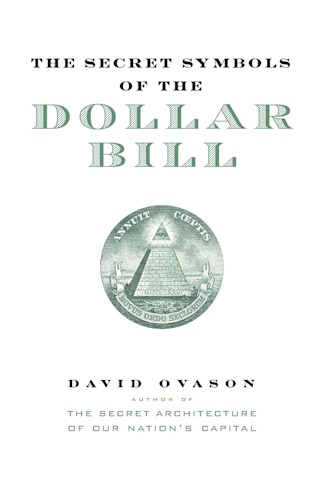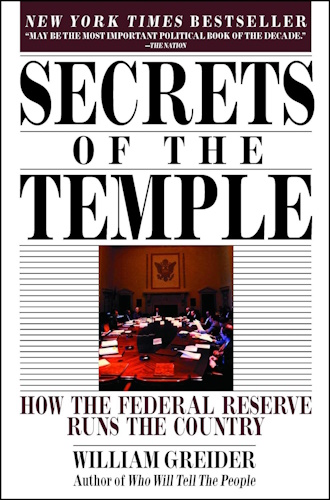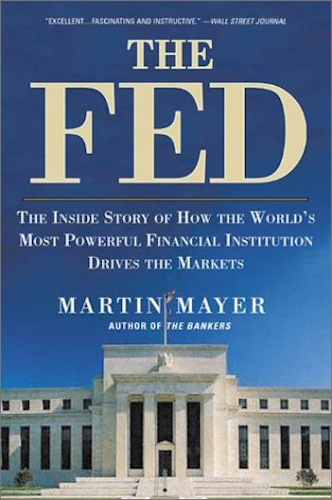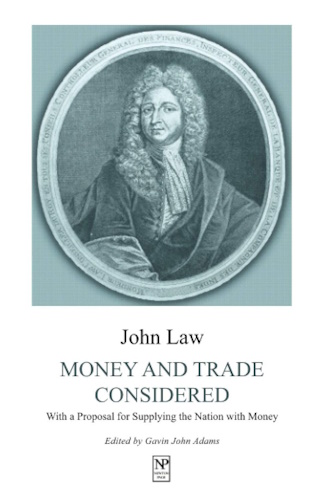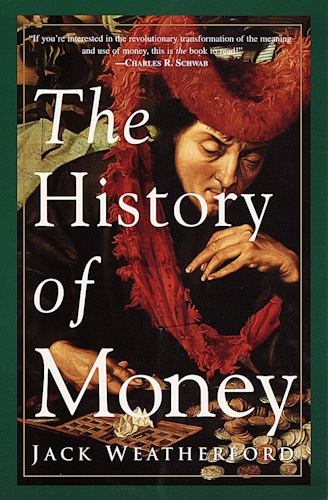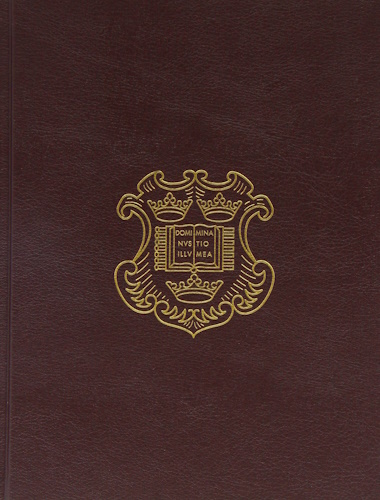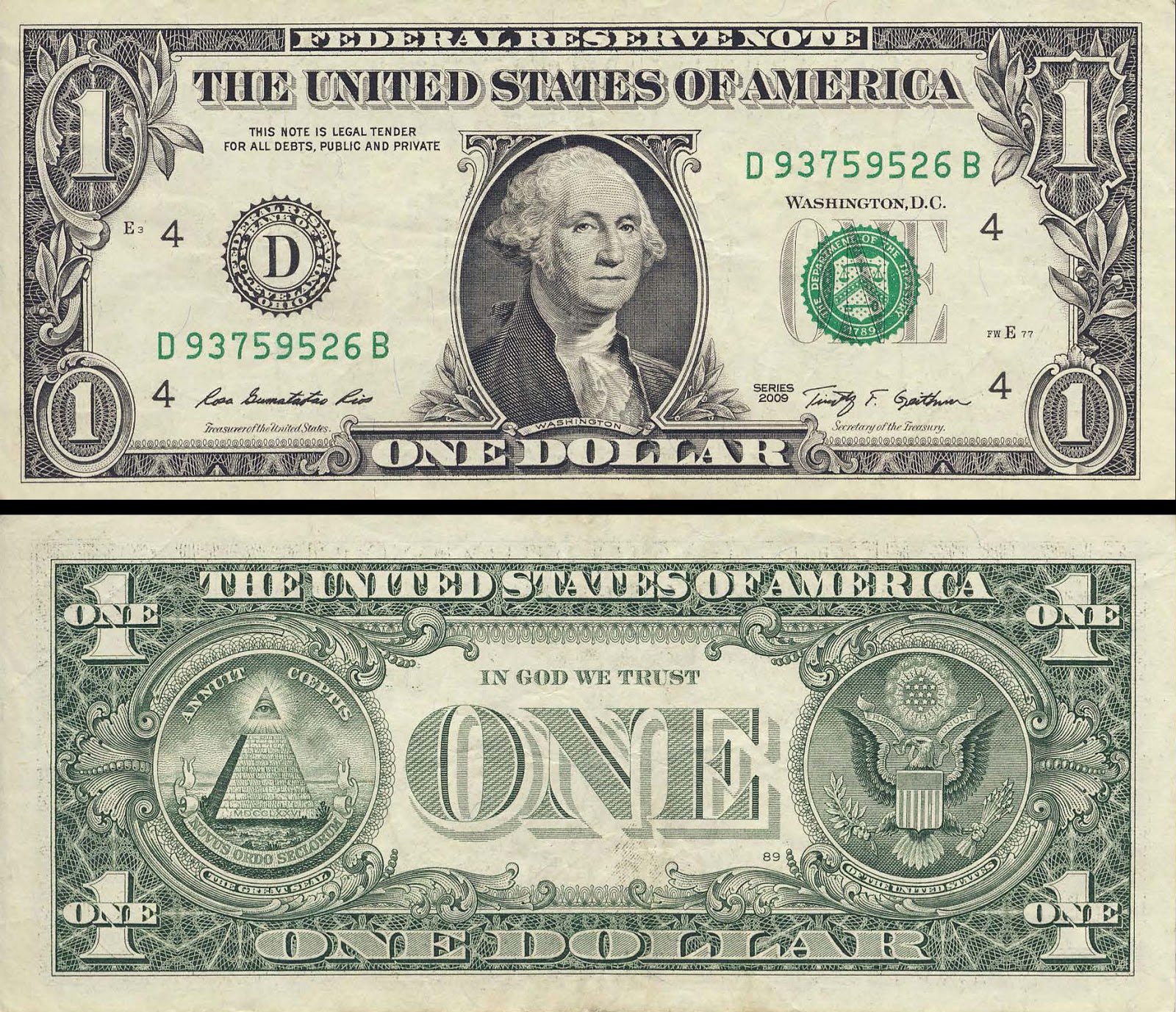![]()
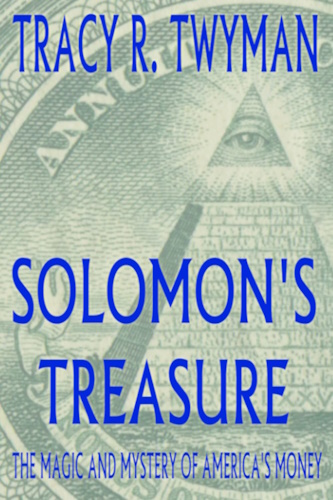
The Magic and Mystery
of
America's Money
by
Tracy R. Twyman
This article is based on the book
Solomon's Treasure: The Magic And Mystery of America's Money
![]()
It is commonly known now, more so than ever before, that the United States of America was founded largely by men with a philosophy grounded in the occult: namely the members of Freemasonry, and other secret societies, who saw in the US a potential "New Atlantis" or "New Jerusalem." They foresaw the future of the United States as a beacon to the rest of the world, guiding the nations towards the formation of a New World Order of peace, democracy, and enlightenment. Many people today would agree that the US is indeed, in several ways, fulfilling this role already. If nothing else, most people would certainly agree that America has come to dominate the world financially, and that among world currencies, the American dollar is king.
But what few people understand is the correlation between the esoteric doctrines of Masonry upon which the United States was founded, and the economic principles that underpin the American economy. Few understand that the dollar is a unit of magical energy, and the dollar bill itself a magical talisman. Although many words have been written by conspiracy theorists analyzing the Masonic symbols on the one dollar bill, no one has yet been able to sufficiently explain why these symbols are there, or what they really mean. Certainly no researcher yet has successfully connected the markings on American money to the hidden secrets of the American monetary system.
The symbolism of the American dollar bill has been the subject of Masonic conspiracy theories since the modern version was first rolled our during the Roosevelt administration in 1935. Masonic and mystical symbolism has been used on American currency since the very beginning, and was employed as a means of distinguishing our money from that of Old World Europe, which invariably featured the bust of the reigning monarch. In contrast, our founding fathers agreed that our money should be decorated with the symbols of the anti-monarchist, pro-democratic Enlightenment philosophy upon which the Republic was founded, and many of these ideals were Masonic in origin. The Great Pyramid, the All-Seeing Eye, and quirky phrases like "Deo Favente Perennis" (God's Favor Through the Years"), or "Mind Your Business" appeared on early American currency. Indeed, the heads of "dead Presidents" and other state figures were not shown on US money until the twentieth century, when it was seen as less taboo. But all researchers of the subject agree that nothing tops the modern American one dollar bill for the sheer exactness and complexity of its mystical symbolism. The meaning of the symbolism is so deep, the metaphors so multi-layered, and each element so precisely placed, that although all of the other American bills have changed their appearance to prevent counterfeiting (with the heads moved off-center, and the addition of funky rainbow colors) the perfection of the one dollar bill has remained intact.
When analyzing the symbolism of the one dollar bill, most researchers tend to focus on the repeated use of the number 13, which they always insist is "an important number sacred to Freemasons," without demonstrating any proof of the supposed Masonic affinity for this particular number. This is, of course, the number of colonies that originally constituted the United States of America, and thus thirteen stars have been used in American heraldry since the start of the union, appearing not only on our first national flag, but upon many of our early coins as well. Since Freemasons were responsible for both the foundation of many of America's institutions and the design of our national symbols, it is tempting to ascribe a Masonic significance to the use of this number, and indeed there may be one. But there is no special mention of the number 13 in any known Masonic ritual, except perhaps in the rites of the Noble Order of the Shrine, where this number seems to be mentioned often, but with no particular meaning given to it. In any case, the Shriners did not exist at the time of the founding of the American Republic. None of the quintessential Masonic tomes, such as Albert Pike's Morals and Dogma, make any special note of the number. Although Pike examines the meaning of many numbers in terms of cabalism and sacred geometry, mention of 13 is conspicuously absent, almost like an office building from the early twentieth century in which the thirteenth floor has been superstitiously omitted. Even Freemason Manly P. Hall, in his 1944 book The Secret Destiny of America
(where he interprets the history of the United States as the unfolding of an ancient Masonic plan) can only offer lamely that 13 symbolizes Jesus and the twelve apostles, or the Sun and the twelve zodiac signs. One would expect him to offer something more interesting, but perhaps he was just being coy. Indeed, if there are any Masonic teachings regarding this number, then they are among the few Masonic teachings that have actually remained secret throughout the centuries. My research tends to indicate that there is in fact a proto-Masonic significance to this number, and one which would have been of special importance to the founders of the United States, had they known about it.
At any rate, Masonic or not, the number 13 is undeniably the most omnipresent, most repeated symbol on the one dollar bill, although its use isn't always explicit. Most of them are featured on the back of the bill. The pyramid on the left has thirteen layers, not including the eye at the top. Above the head of the eagle on the right, there is a constellation of thirteen pentagonal stars, arranged in the shape of a Seal of Solomon. There are thirteen leaves on the olive branch in his right talon, and thirteen "Jonathan arrows," as they're called, in his right. There are thirteen horizontal divisions on the eagle's shield, and thirteen vertical ones. The motto "E Pluribus Unum," written on the banner in his beak, contains thirteen letters. So too does the motto "Annuit Coeptis," written above the pyramid on the left. Furthermore, if you add the number of letters in "Novus Ordo Seclorum" and "MDCCLXXVI" ("1776" in Roman numerals) written below the pyramid, you get 26, or two sets of thirteen. On the front of the bill, at the base of the portrait of George Washington, on each side there are eight leaves and five berries, indicating another two sets of thirteen. There are also thirteen stars on the chevron on the seal of the Treasury Department that is featured to the right of Washington, overlaying the word "ONE."
Clearly these allusions to the number thirteen are no accident. This truth is compounded by the letters in permanently featured words on the front of the dollar bill (that is, words not contingent upon any changing circumstance, such as the name of the US Treasurer). These words include: "FEDERAL RESERVE NOTE"; "THE UNITED STATES OF AMERICA"; THIS NOTE IS LEGAL TENDER FOR ALL DEBTS PUBLIC AND PRIVATE"; "WASHINGTON, D.C."; "ONE"; "TREASURER OF THE UNITED STATES"; "SECRETARY OF THE TREASURY"; "ONE DOLLAR; and "WASHINGTON." The total number of letters in these words is 169, or 13 squared.
Returning to the back of the bill, there would appear to be exactly thirteen examples of the use of the number 13 there. But in order for this to be correct, you have to count "IN GOD WE TRUST." Of course, there are only twelve letters in this phrase, but occupying the same space in the center on the back of the bill is the word "ONE," implying that we should add 1 to this sum and make 13. This leads us to the thirteenth example of the use of 13 on the back of the bill. There are twelve occurrences of the number "1" or the written word "one," unless you count the Latin word "unum," meaning "one," used once, which makes 13 in all.
In fact, this emphasis on "one" on the one dollar bill is yet another mysterious motif. The concept of "unity" could in fact be said to be the real underlying theme of the one dollar bill. And rightly so: it represents, after all, the original unit of currency upon which the American economic system is founded. It is the blueprint upon which all other dollar bills are based, and when we think of the American dollar, the first image that pops into our minds is the one dollar bill. As the official representation of the original unit underpinning the economy, its unity is expressed with the plenteous use of "1," the central placement of "ONE" on the back of the bill, and the use of the motto "E Pluribus, Unum" ("Out of Many, One") underneath a constellation of thirteen stars, representing the original colonies that were "unified" at the creation of the United States. The theme of "one" is continued with the use of the first American President, George Washington, on the front of the bill, and with the word "ONE" written next to him. As well, I would include the symbol of the pyramid on the back, which according to the designers of this emblem, was meant to represent the ideal state, made up of individuals (the stones) unified into one structure (the pyramid), under the divine unifying principle (the All-Seeing Eye of Providence).
Other strange features include the words "Annuit Coeptis" ("He [meaning God] favors our undertaking") and "Novus Ordo Seclorum" ("The New Order of the Ages"). These are both based on quotes from the Roman poet Virgil, although they have been slightly altered, and both quotes referred in their original context to "Juppiter Omnipites" ("Omnipotent Jupiter"), essentially the Roman equivalent of the Judeo-Christian Almighty God. (Interestingly, "E Pluribus Unum" is also a quote from Virgil slightly altered, and some see in these alterations a numerological significance.) In the original Virgil poem, the words "Juppiter Omnipotes, Audacibus Annue Coeptis" were a plea for the deity to "favor my daring undertakings." The words on the back of the dollar bill not only plea for, but confidently declare, God's favor upon the "daring undertaking" there represented: creation of a "New Order of the Ages," or new global power structure, headed by the newly-created republic of the United States. For these symbols and words belong not just to the dollar bill. They are part of the Great Seal of the United States, created in 1776, at the same time the nation was founded. It is the front and back side of the Great Seal which is represented on the back of the dollar bill.
The design of the Great Seal has never been ascribed to any one individual, and it has evolved a bit over the years. But the essentials of the design were sketched out right at the beginning, in 1776, the year of the Revolution, emblazoned in Roman numerals beneath the pyramid on the back of the seal. That's right: the roundel featuring the eye above the pyramid is actually the reverse side of the great seal, and the roundel featuring the eagle is really the front. It is the front of the Seal which is used to seal official US documents, not the back. Several people are known to have contributed to the design of both sides of the Seal, including Benjamin Franklin, Thomas Jefferson, William Barton, Charles Thomson, and Pierre Eugene du Simitiere, and all but one were Freemasons. The first metal die for the Seal was cut by Robert Scot, a Freemason, in 1782. However, although dies were commissioned for both the front and the back of the seal, only the front was actually cut. No die was made for the back of the seal until much later, and most people were not aware that their national seal had a back to it at all until it appeared on the dollar bill in 1935. Thirty-third degree Freemason and historian Manly P. Hall wrote that the reverse of the seal was not originally used, "because it was regarded as a symbol of a secret society and not the proper device for a sovereign state."
Just like the Great Seal, the one dollar bill was also designed by a group of Freemasons working for the government; in this case, President Franklin Roosevelt, Secretary of Agriculture Henry A. Wallace, and Secretary of the Treasury Henry Morgenthau, although the design was executed at the Bureau of Engraving and Printing (which employed exactly thirteen engravers). It was Wallace's suggestion that the front and back of the Great Seal be used on the reverse of the dollar, although he originally wanted the front of the seal to be on the left, and the back of the seal to be on the right, which makes sense logically. But it was President Roosevelt who suggested switching that order, and putting the more interesting reverse of the seal on the left, which made more sense intuitively, since the Western eye naturally reads words and images from left to right.
"In God We Trust" was not placed on the bill until 1957. However, it was originally made the national motto of the United States in 1863 at the suggestion of Treasury Secretary Salmon P. Chase, who himself had supposedly been prompted to do so by a protestant minister concerned with the waning of religious fervor in the American public. This man purportedly wanted to ensure that the US would always be officially grounded in faith in divine Providence, and thus this motto was put on all American coins ever since, although it did not appear on paper currency until much later. But "In God We Trust" is indeed a Masonic motto – one used in almost all Masonic rituals, in which the participants must pledge to always put their "trust in God" during the ceremonies – and this specific phrase can be found in Masonic dictionaries. Its appearance on the dollar bill in the 1950s may have been meant to bolster a currency increasingly dependant on faith due to changes in American monetary policy.
This process began in earnest in the 1930s, right around the time that the new one dollar bill was being designed. In an effort to help America climb out of the Great Depression, Roosevelt began employing the economic policies of advisor John Meynard Keynes, who suggested that, during times in which the private sector wasn't producing enough investment to stimulate the economy, the government should become the investor, financing public works, and dumping money into the system in whatever way possible to grow the economy. Thus he instituted the "New Deal," creating an "alphabet soup" of bureaucracies, many of which have now become mainstays of federal government. Among these was the FDIC, or Federal Deposit Insurance Corporation, which insured bank accounts to a limited amount in the event of a bank's failure – something that was necessary after a number of bank failures had occurred in the previous years. And it may not be an accident that "FDIC" implies the word "fiducial," a financial term with its roots in the Latin word "fides," which means "trust, confidence, reliance, credence, belief, faith…. credit." (Fides was symbolized in the Mithraic mysteries by two hands clasped together, now a common Masonic motif, and the logo of Allstate insurance.)
It was this "faith" in the American dollar that Roosevelt and his friends may have been attempting to create with the new design of the dollar bill. And that faith was sorely needed, for in order to free up the money needed to finance the New Deal, Roosevelt instituted sweeping changes to the country's monetary policy. He removed the dollar from the "gold standard" to which it had been implicitly set, so that he could have the money supply greatly expanded with no predetermined limit. It worked to stabilize the economy just in time for the United States to enter WWII, which turned out to be another great economic stimulator.
As part of removing the gold standard, Roosevelt had laws passed forcing US citizens to give all of the gold and silver that they owned to the government, in exchange for an equivalent amount of paper dollars. Americans' faith in the new system was severely tested the following year when the government devalued the dollar relative to gold, thus causing all who had made the exchange to lose 41% of the value of their money.
On July 22, 1946, at the end of WWII, an agreement was signed at a conference between 44 nations in which the other countries agreed to value their currencies in relation to the dollar, rather than gold, silver, or anything else. The US then set the value of the dollar at $35 per ounce of gold, and agreed to redeem dollars held by the central banks of other nations in gold upon demand. However, this led to a steady loss of US gold reserves, until finally, in 1971, President Richard Nixon closed the "gold window," announcing that the holdings of foreign central banks would no longer be redeemed for gold by the US government.
This was the final step in abandoning the gold standard. Now the value of the dollar floats freely in relation to foreign currencies, with no fixed standard of value. The value can only be manipulated by the market forces of the economy, and by the actions of the Federal Reserve. The result has been rapidly expanding inflation, which began during the Nixon years, and which has been felt by all the foreign currencies that were pegged to the dollar. Many of these currencies have repeatedly failed, and the governments of their countries remained continually insolvent, ever since.
So the dollar that we now use is one backed entirely by faith alone – the public's faith in America's economy, and America itself. The economies of other nations are dependant upon this faith as well. For if no one believed in the power of the dollar – if it was not universally accepted as a form of payment – then it would have no value. As Jack Weatherford writes in The History of Money:
The government will not redeem a dollar bill for anything other than another dollar bill. The dollar is simply fiat currency. The dollar rests on the power of the government and the faith of the people who use it – faith that it will be able to buy something tomorrow, faith that the US government will continue to exist and to accept dollars in payment of taxes and pay them out in expenses, and faith that other people will continue to believe in it. Aside from that faith, nothing backs up the dollar.
Likewise, William Greider wrote in Secrets of the Temple: How the Federal Reserve Runs the Country that:
Above all, money [is] a function of faith. It [requires] an implicit and universal social consent that [is] indeed mysterious. To create money and use it, each one must believe, and everyone must believe. Only then [do] the worthless pieces of paper take on value. When a society [loses] faith in money, it [is] implicitly losing faith in itself… The money process… [requires] a deep, unacknowledged act of faith, so mysterious that it could easily be confused with divine powers.
Of course, even before paper money became widely used, the worth of gold and silver coins rested on a similar social contract – a common, agreed-upon value. But the difference is that gold and silver have intrinsic value, and when these coins were used in the past, their value was roughly equal (when made properly) to the value of the metal of which they consisted. But our current paper dollars are "fiat currency" – representations of wealth that have no physical existence until they are used to purchase something that does – in which case, they cease to be dollars.
The use of paper money was not new to America in 1935. They have been used throughout our history, beginning with the "continentals" which financed the Revolutionary War, and which were backed with nothing more than the promise that America would win the war, and begin collecting taxes from its citizens. A similar gamble was taken during the Civil War, which was financed by "Greenbacks," forebears of the modern paper dollar. In addition to these two currencies, each of which were issued by the federal government, there were, throughout the United States' early history, many paper dollars in circulation that were issued by privately-owned banks throughout the various states. These dollars differed widely in appearance from one another, which led to massive counterfeiting, and when the banks failed, which they often did, the dollars became worthless. Numerous measures were taken by the federal government in attempts to control this problem. Finally, in 1913, a series of banking collapses inspired the creation of the nation's new central bank, the Federal Reserve, and a new banking and monetary system, the Federal Reserve System.
The Federal Reserve is now the United States' national bank, and it is both quasi-governmental and privately-owned. It sets the basic operating policies for all of its member banks (which is most of the banks in the U.S.), and provides them with their money supply. The process they use to supply this money, "fractional reserve lending," is not new. It's almost as old as banking itself. But when backed by a powerful dynamo like the Fed, which created tremendous faith in the integrity of the money supply, the new money system became an unstoppable force. In fractional reserve lending, a bank can take the money from its depositors' accounts, and lend it out to various persons or institutions on interest. It can loan out the vast majority of the money deposited (say, 87%), leaving only a fraction (13%) in the bank's vaults. This fraction is called the "reserve," and it is the only "actual" money sitting in the bank, backing all of the various loans - the only money that is really ready to be withdrawn, should the depositors choose to withdraw from their accounts.
When the loans are paid back, the bank earns a profit from the interest. Thus, the bank has caused its depositors money to multiply, and has kept the difference for itself, essentially creating money out of nothing. If the bank has loaned money to another bank or financial institution, that institution can then loan it out and create even more money out of nothing. Or they can loan it to a person or business who can use it earn more money by producing goods and services that are sold. This money is then spent into the economy again. Thus the money supply multiplies exponentially, and the economy itself acts as a money multiplier – a manna machine, in a way. Money can always be used to make more money.
Now since the Federal Reserve is the point of origin for this money, its initial injection into the system is sometimes called "high-powered money," because it effects the whole economy. It is the tiny mustard seed which causes the rest of the money supply to grow. The interest rate which the Fed chooses to set for the money it lends determines how much money will be borrowed by other banks at that time, and also determines the rate that those banks will charge for loaning money. This is the primary way in which the Federal Reserve controls the money supply, and thus, as much as possible, the American economy: too much money being loaned out (and thus created) leads to inflation, and too little leads to recession. When the Fed first loans it out to the member banks, the money is "created," and each time those banks lend it out, they are breeding more. As Martin Mayer writes in The Fed: The Inside Story How World's Most Powerful Financial Institution Drives Markets:
… The Fed's actions were always and necessarily pretty small by comparison with the effects desired, and their effectiveness was explained by the operation of a 'multiplier' inherent in a system where banks had to keep 'reserves' against some fraction of their liabilities. The bank that received the Fed's 'high-powered money' might lend 90 percent of it, and the bank that received the proceeds of that loan would lend 90 percent of that, producing deposits in another bank that would lend 90 percent of that, etc…"
Some see the way in which fiat currency, especially paper and electronic money, can be simply "created, as nothing short of magic. Scottish philosopher John Law wrote in his 1705 book, Money and Trade Considered: With a Proposal for Supplying the Nation with Money, that he had discovered the "Philosopher's Stone" of the alchemists, which could purportedly turn lead into gold, or dross into something valuable. The key to alchemy, he said, was the printing of paper money, and in 1715 he was hired by the French government to put his theories into action. Law was put in charge of France's national Banque Royale, as well as the Mississippi Company, which gathered investments from French citizens to finance operations in French Louisiana, promising the investors profit payments. He set up a paper-passing scheme between the bank and the Company, in which investors could borrow paper money printed by the bank to invest in the Company. They were expected to pay back the bank in gold, while the Company paid their profits in the bank's paper money, which was supposedly redeemable in gold. The whole scheme collapsed dramatically in what became known as "the Great Mississippi Bubble," and Law fled in disgrace, dying shortly thereafter. But his ideas went on to influence German writer Wolfgang von Goethe.
In Goethe's classic play, Faust, the title character and his teacher, Mephistopheles (the Devil), gain the favor of the emperor by offering him the secret of alchemy: how to create wealth by printing paper money. Soon the emperor presides over a robust economy and a licentious, materialistic people. But the currency eventually collapses, just as all the Devil's creations turn out, in this play, to be illusions.
It is my belief that the Freemasons and other occultists who have been responsible for creating the United States, designing the dollar bill, and engineering our economy have understood the principles of alchemy, and have purposely chosen to construct our economy upon these principles: the principles of creating worth from worthlessness, and for creating a large volume from a small one, using the power of faith. I explain my theory in much greater detail in my book Solomon's Treasure: The Magic And Mystery of America's Money. In this book, I demonstrate that the creation of money by the Federal Reserve, and its exponential multiplication by the procedures of the banking system, is analogous to the creation and multiplication of gold in alchemy. The power of money to transform almost any thing or situation into another is similar to the alchemical power of the so-called "Universal Agent" or "Philosopher's Stone," and the act of turning paper into dollars is like turning lead into gold. The members of the Federal Reserve Board are in many ways like sorcerers, conjuring wealth seemingly out of thin air and distributing it at will to transform the American economy according to their desires. The dollar is "fiat currency," declared into existence by the central bank in a manner similar to the creation of the universe by the divine words "Fiat Lux!" - "Let there be light!" Fiat money (best exemplified by the American dollar) is perhaps the only thing that truly means nothing, and has no independent existence, except in relation to something else (i.e., what it can buy, or be converted into), and yet it is the most powerful force within the human sphere of life – like the "Azoth," or secret essence of life spoken of in alchemical texts. In Solomon's Treasure
, I explore the history of the dollar prior to the formation of the Federal Reserve in 1913, and conclude that most of these magical principles were at work in the American economy from the very beginning.
As stated, this system depends entirely on a religious faith by the American people in the supernatural power of the dollar. The ability of the United States President and other elected officials to uphold and improve the economy depends largely upon their ability to manipulate the spiritual will of the people, in much the same way that a priest or a magician would, inspiring them to have faith in the value of the dollar. This faith is reinforced by the financial terminology currently in use ("trust," "fiducial," "credit," etc.), as well as by watchwords and symbols found on American money – not only on the bills and coins we currently use, but on those dating back from before the formation of the Republic. These objects thus act as magical charms, containing a unit of magical charge that is passed on from one person to the next, and multiplied, as the money changes hands. They also act as tokens of communal trust in, and fidelity to, the dollar as an institution. The symbols and key phrases associated with it thus work to enchant the public into a mass hypnotic spell, in which the mind of each individual confirms the consensus belief in the power of a dollar, and its ability to multiply itself as it moves through the system. Every time a person spends a dollar, or accepts a dollar as payment, they are confirming their belief in the dollar, and using it to exercise their spiritual will.
Now the mysterious markings on the dollar bill can be understood. The words "In God We Trust" are meant to inspire faith in the dollar as a currency, and faith in the American republic. One should trust the dollar the way one trusts in God, for it is implied that God himself has chosen to favor the U.S. and, by extension, the dollar. This is communicated by the message on the reverse of the Great Seal, "Annuit Coeptis" – "He [God] favors our undertaking." The words "E Pluribus Unum" and the other twelve examples of "one" on the bill, along with the pyramid, remind us that our society is made up of various parts that are essentially united, and money is the great uniter, since it is the one thing that everyone in the country uses. The spider web motif in the background of the bill's design shows that we are all connected through the web of commerce. The bald eagle on the front of the Great Seal looks a bit peculiar, and Masonic expert Manly P. Hall claims that it is meant to secretly represent the phoenix, the mythical bird who eternally dies and is reborn, and which is a symbol of transformation in alchemy. (Indeed, the original proposals for the design of the Seal didcall for a phoenix instead.) Even the green color of U.S. dollars is symbolic, representing fecundity, plenteousness, and growth. Former U.S. Treasurer Mary Ellen Withrow explicitly stated in a interview with New Yorker Magazine that this is why the color green is used.
The meaning of the number thirteen is related to alchemy as well. As I explain in my book, the number 13 symbolized, for one proto-Masonic society, a concept which was itself equivalent to the idea of the Philosopher's Stone. I am speaking of the Knights Templar, progenitors of modern Freemasons, and inventors of modern banking. Their concept of God, which they called "Baphomet," was symbolized by the number thirteen, and as I will explain in Part Two, Baphomet was, to them, the key to applied alchemy – both economically and otherwise. I believe that the Templars passed on the secrets of alchemy to the Freemasons, who utilized them in the creation of the U.S. dollar. Incidentally, the use of the number 13 can be found not just on the one-dollar bill, but throughout the structure of the U.S. monetary system – in the way the Federal Reserve operates, for instance. One of the most striking examples, however, is the fact that there are exactly six types of coins, and seven denominations of paper money, currently in circulation in the U.S.
Indeed, since the beginning, the dollar itself, independent of its manifestation as paper money, bore the markers of alchemy. The dollar did not begin with the U.S.A. The first "dollars" ever minted (called "thalers" in German) were silver dollars coined in Joachimsthaler, Bohemia, by a man named Georgius Agricola, who had up until that point been a practicing alchemist seeking the Philosopher's Stone. He found coining dollars to be the answer to what he was seeking, and later became known as the "Father of Mineralogy" because of the science he developed while mining and minting.
In addition to this, the dollar sign ($) seems to have an alchemical connotation as well. It is thought to have been chosen by Thomas Jefferson, who was responsible for the U.S. adopting the dollar as its national currency. But the sign's origin remains a mystery. I have always thought it to be reminiscent of the Caduceus, the magical wand of Hermes, a staff with a serpent entwined upon it, which has long been a symbol of alchemical transformation and healing (thus its use by the medical profession). Author David Ovason, in The Secret Symbols of the Dollar Bill, concurs, and adds that a symbol almost identical to the dollar sign is used in astrology to denote Mercury, the Roman version of Hermes, the god of alchemy.
There are other theories on the origin of the dollar sign, all with the same ultimate meaning. Early Spanish dollars featured the Pillars of Hercules, and the words "Plus Ultra" (meaning "More Beyond") written on banners that were wrapped around the pillars. To the Europeans, the New World of America was the long-fabled land beyond the Pillars of Hercules, and these "pillar dollars" were widely circulated throughout colonial America. The dollar sign thus supposedly evolved, according to this theory, to represent two pillars wrapped in a banner (recalling that the earliest versions of the $ sign included two horizontal lines, not one). But Masonic author Albert Pike has pointed out that the coins of ancient Tyre featured serpents coiled around trees, representing the Garden of Eden and the Tree of Knowledge – an equivalent symbol to the Caduceus. And author Ignatius Donnelly (Atlantis: The Antediluvian World,) stated his belief that the dollar sign represented the Pillars of Hercules entwined with the serpent of Genesis.
In the forthcoming Part Two of this article, I will reveal, as I do in Solomon's Treasure, the origins of the magic of the dollar with the Knights Templar. The discovery by the Templars of the secrets of alchemy, its connection to the number 13, and the Templars' creation, using this secret, of the modern banking system, will be explored. It will then be explained how this alchemical secret relates to the fabled treasure of King Solomon. These facts should cause all to examine more carefully, and learn to appreciate, the complex mystical qualities of the money that so many of us take for granted.
Bibliography:
Goodwin, Jason. Greenback: The Almighty Dollar and the Invention of America. Henry Holt & Company, 2003, New York, NY.
Greider, William. Secrets of the Temple: How the Federal Reserve Runs the Country. 1987, Simon & Schuster, New York, NY.
Hall, Manly P. The Secret Destiny of America. The Philosophical Research Society, 1991, Canada.
Ovason, David. The Secret Symbols of the Dollar Bill. Harper Collins, 2004, New York, NY.
Weatherford, John. The History of Money. Random House, 1997, New York, NY.
![]()
![]()
Disclaimer:
Some material presented will contain links, quotes, ideologies, etc., the contents of which should be understood to first, in their whole, reflect the views or opinions of their editors, and second, are used in my personal research as "fair use" sources only, and not espousement one way or the other. Researching for 'truth' leads one all over the place...a piece here, a piece there. As a researcher, I hunt, gather and disassemble resources, trying to put all the pieces into a coherent and logical whole. I encourage you to do the same. And please remember, these pages are only my effort to collect all the pieces I can find and see if they properly fit into the 'reality aggregate'.
Personal Position:
I've come to realize that 'truth' boils down to what we 'believe' the facts we've gathered point to. We only 'know' what we've 'experienced' firsthand. Everything else - what we read, what we watch, what we hear - is what someone else's gathered facts point to and 'they' 'believe' is 'truth', so that 'truth' seems to change in direct proportion to newly gathered facts divided by applied plausibility. Though I believe there is 'truth', until someone representing the celestial realm visibly appears and presents the heavenly records of Facts And Lies In The Order They Happened, I can't know for sure exactly what "the whole truth' on any given subject is, and what applies to me applies to everyone. Until then I'll continue to ask, "what does The Urantia Book say on the subject?"
~Gail Bird Allen
![]()
![]()


 ,
,  , released in October 2004 on Dragon Key Press,
, released in October 2004 on Dragon Key Press,  . Her latest is
. Her latest is  , co-written with Alexander Rivera of The AeonEye.com. Before writing books, she made a name for herself as the Editor and Publisher of a highly unique magazine entitled Dagobert's Revenge - a journal dedicated to the Merovingians, the Grail and Rennes-le-Chateau - which was published from 1996 to 2003.
, co-written with Alexander Rivera of The AeonEye.com. Before writing books, she made a name for herself as the Editor and Publisher of a highly unique magazine entitled Dagobert's Revenge - a journal dedicated to the Merovingians, the Grail and Rennes-le-Chateau - which was published from 1996 to 2003.